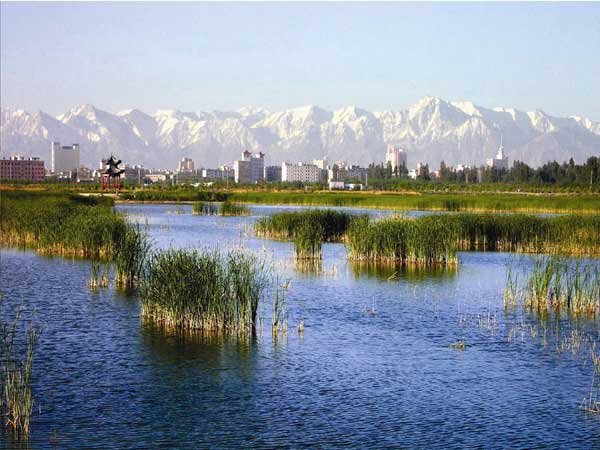Both ends of the Heihe River struggle for water
 |
|
The shortage of water has led to the shrinking of the size of wetlands in Zhangye. Tuo Xingfu / for China Daily |
Zhangye has never been so thirsty for water as it is today. Its fall as a trade and military center came after the Ming Dynasty (1368-1644), when Chinese turned to marine navigation for international trade. Its decline as an agricultural-production base and human habitat is happening now with the shortage of water.
The population of the city has tripled since the 1950s, and the area of farmland has expanded by 2.5 times. In the late 1990s, Zhangye had 92 percent of the population of the drainage area of the Heihe River and consumed 76 percent of its water resources.
The river's supply of water to the lower reaches of the Ejin Banner of the Inner Mongolia autonomous region has declined sharply since the 1960s. Not a single drop of water has reached East Juyanhai Lake, the river's natural destination in Ejin Banner, since the late 1980s.
From 1960 to 2000, the Ejin Banner saw 2,700 hectares of native poplar trees wither and die. West Juyanhai Lake, which measured 267 square km in the 1950s, and East Juyanhai Lake, once 35 square km, dried up in 1961 and 1992.
Consequently, the Badain Jaran Desert became a new source of sandstorms affecting North China in the 1990s. The desert was quick to encroach on Zhangye.
In 2000, the central government finally ordered Zhangye to allow at least half of the river's water to flow past and revive the thirsty downstream area. In the past 12 years, Zhangye's share of the Heihe River's water has declined from 76 percent to 43 percent.
Thanks to the water distribution reform, East Juyanhai Lake had grown to 40 square km by 2012. The overall vegetation coverage of Ejin Banner has increased by 30 percent in the past 10 years.
The Torghut Mongolian people, who left their homes years ago, are moving back to the lake.
|
 |
"I appreciate the government's policies and the sacrifice of the people living in the upper reach of the Heihe River," says Ai Dong, 38, a resident in Ejin Banner. "Our ancestors settled here 300 years ago, and we became ecological refugees 10 years ago. Now I have 200 sheep and eight cattle. My family makes more than 10,000 yuan ($1,587) in the three-month tourism season each year."
However, cutting the water supply by half for a city of 1.3 million people is not an easy mission, despite local officials' expressed optimism to the central authorities. The city government has distributed the limited water carefully among different sectors, as if they were rationing gasoline in wartime.
Local farmers converted all rice paddies into corn fields. Wang Zhiyi, an expert on wetland conservation in Zhangye, worries: "After the farmers built concrete canals and trickle irrigation system to replace the former flooding irrigation system, trees are dying in large numbers in the countryside."
Shen Yulu, a local civil servant, echoes Wang: "You know how much effort we made to plant these trees? It is really heartbreaking to see them wither and we cannot do anything."
About 62 percent of the city's area suffers from serious water and soil erosion. More than 60 percent of the city's grassland has become desert or semi-desert.
Yuan Donghua, a 48-year-old female farmer, was moved away from the wetland by the government. "I have lived in the wetland all my life," she says. "The size of the wetland kept shrinking - at first, because of farmers' cultivation, and now, because of the lack of water."
Cheng Zihu, 64, a farmer in Linze county in Zhangye, who became famous for desertification control, says: "The temporary success attained through human efforts in controlling sand, against a bigger backdrop of water shortage, is like winning a battle in a doomed war."
Cheng says that, in the past 10 years, the desert's approach has been halted, and its edge pushed back by 9 km. "We have no choice. It is a life-or-death fight for us."























